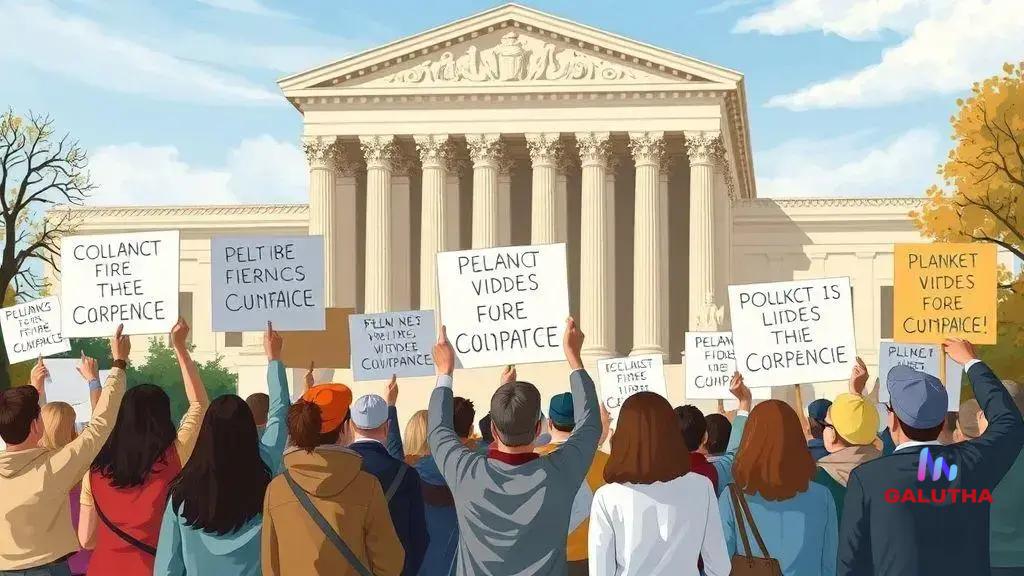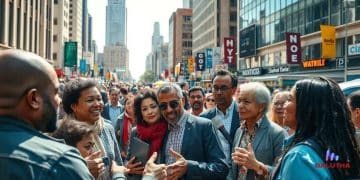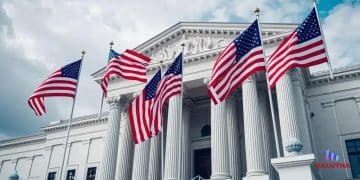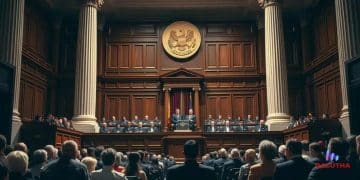Supreme Court rulings that shaped American law

Supreme Court rulings directly shape daily life by influencing individual rights, workplace policies, and social norms, while also addressing current legal challenges and evolving interpretations of the Constitution.
Supreme Court rulings are pivotal moments in American history, shaping laws and influencing the direction of society. These decisions often reflect the evolving values of our nation and have long-term ramifications. Let’s dive into the key cases that define and impact our legal landscape.
Key Supreme Court cases throughout history
Key Supreme Court cases have significantly influenced the legal landscape of the United States. Understanding these landmark decisions helps us grasp the evolution of American law and its impact on society.
Brown v. Board of Education (1954)
This pivotal case declared racial segregation in public schools unconstitutional. It laid the groundwork for desegregation across the country, showcasing the Supreme Court’s role in promoting civil rights.
Roe v. Wade (1973)
The ruling in Roe v. Wade established a woman’s legal right to privacy regarding her choice to have an abortion. This case sparked debates and ongoing discussions about reproductive rights in America.
Miranda v. Arizona (1966)
Miranda v. Arizona changed law enforcement procedures by requiring police to inform suspects of their rights during an arrest. This decision is essential to understanding individual protections against self-incrimination.
- Key principles established by this case include the right to remain silent.
- It emphasizes the importance of legal representation.
- Miranda rights are now a crucial part of police training across the nation.
Each of these cases illustrates how the Supreme Court has shaped the rights and freedoms of American citizens over time. The influence of these rulings extends beyond the courtroom, impacting social movements and legislation.
By examining these critical rulings, we can appreciate the ongoing evolution of law in response to societal needs. As issues like civil rights and personal freedoms continue to unfold, the legacy of these cases remains relevant.
Impact of Supreme Court decisions on society

The impact of Supreme Court decisions on society is profound and widespread. These rulings not only affect the legal framework but also shape social norms and public policy.
Protecting Civil Rights
Supreme Court decisions, such as Brown v. Board of Education, have played a crucial role in advancing civil rights in the United States. This landmark ruling helped to dismantle racial segregation, marking a pivotal step towards equality in education. Its effects rippled through various aspects of life, influencing legislation and inspiring social movements.
Influence on Personal Freedoms
Another significant facet is how rulings like Roe v. Wade, which established reproductive rights, have shaped conversations around personal freedoms. The decision not only secured a woman’s right to choose but also ignited debates that continue to resonate today.
Shaping Public Opinion
Decisions made by the Supreme Court can shift public opinion. When controversial rulings are made, they often prompt public dialogue and increase awareness about critical issues. For instance, decisions regarding same-sex marriage have advanced understanding and acceptance of LGBTQ+ rights.
- Supreme Court rulings educate citizens about their rights.
- They can inspire activism and lead to reforms.
- Many decisions create legal precedents that influence future cases.
As society evolves, the Supreme Court continues to play a vital role in affecting both individual lives and collective rights. Understanding these impacts helps us appreciate the dynamic relationship between law and society.
The interaction between court decisions and societal values highlights the importance of the judiciary in maintaining a balance between liberty and order. Each ruling serves to reinforce or challenge prevailing norms, making the role of the Supreme Court essential in our democratic process.
Controversial rulings and their implications
Controversial rulings by the Supreme Court often spark heated debates and discussions across the nation. These decisions can bring about significant changes in the law and influence societal perspectives.
Citizens United v. FEC (2010)
This case allowed for unlimited spending by corporations in politics, deeming it a form of free speech. As a result, it changed the landscape of political funding, leading to concerns about the influence of money in elections.
Helller v. District of Columbia (2008)
In this ruling, the Supreme Court affirmed an individual’s right to possess a firearm unconnected with service in a militia. This decision intensified the ongoing debate over gun control laws in America.
- Supporters argue it protects personal freedom and self-defense.
- Opponents worry it undermines public safety and leads to increased violence.
- Both sides use this ruling to advocate their positions in legislative debates.
These decisions demonstrate how the Supreme Court’s interpretations can lead to lasting implications for society. As controversial rulings arise, they often spark movements and responses from different groups, shaping public policy and opinion.
Each ruling also reflects societal values and issues present at the time. As laws evolve, public reaction can affect how future cases are perceived and litigated.
As the nation continues to discuss these significant rulings, the implications often transcend legal boundaries, affecting daily life and the political landscape.
Future trends in Supreme Court jurisprudence

The future trends in Supreme Court jurisprudence are uncertain, yet they promise to shape the legal landscape profoundly. As societal values evolve, the Court will likely address new challenges and revisit established precedents.
Increased Focus on Technology and Privacy
As technology advances, issues of privacy and data security are becoming more prominent. Cases involving digital privacy and the rights of individuals in the digital space will likely rise. Courts may have to interpret laws that were written long before the internet era, setting key benchmarks for future technology-related litigation.
Social Justice and Equality
More cases centered around social justice and equality are anticipated. Topics such as racial justice, LGBTQ+ rights, and economic inequality could drive legal battles that challenge existing norms. The Court’s approach to these issues will reflect wider societal movements advocating for equality.
- The Court may expand protections against discrimination.
- Emerging social movements will likely influence judicial decisions.
- Legal challenges may arise from new legislation relating to social justice.
Another possible trend is a shift in how the Court interprets constitutional rights. There may be a greater emphasis on individual liberties versus the government’s role in regulating those rights. This dynamic could lead to significant legal debates and changes in how laws are applied.
The Constitutional interpretation employed by justices is essential in predicting which way the Court might lean on various cases. Traditional methods may clash with more progressive or modern interpretations, shaping future rulings.
Ultimately, the Supreme Court will face evolving issues that reflect changes in society. The interaction between the Court’s rulings and public sentiment will likely guide its direction as we move forward.
How Supreme Court decisions affect daily life
Supreme Court decisions profoundly shape our daily lives and how laws are applied in various aspects. These rulings often translate legal concepts into practices that affect individuals directly.
Rights and Freedoms
Everyday rights, such as free speech and the right to vote, stem from Supreme Court interpretations. For instance, the verdict in Citizens United v. FEC established that corporations can spend money on political campaigns, influencing the political landscape. This ruling impacts how elections are financed and can shape the policies that affect people’s daily lives.
Legal Protections
Decisions surrounding workplace rights, like Price Waterhouse v. Hopkins, provide protection against gender discrimination in hiring practices. Employees must understand their rights to ensure a fair workplace.
- Legal decisions can set important precedents for workplace conduct.
- The outcomes of certain cases create rules that employers must follow.
- People are empowered to challenge unfair practices due to these rulings.
Additionally, rulings related to civil rights have cultivated changes in social norms. Laws promoting equality and advocating against discrimination in various forms derive from critical cases. These changes resonate through communities, influencing cultural expectations and behaviors on issues like marriage equality and access to education.
Another crucial area is the impact of judicial decisions on public health and safety. The Supreme Court ruling in Whole Woman’s Health v. Hellerstedt illustrated how regulations on healthcare facilities can affect access to reproductive health services. Such decisions highlight the direct link between legal interpretations and services available to the public.
As these decisions continue to evolve, their effect on everyday life becomes more apparent. Citizens often feel the ripple effects of high-profile court cases in their local communities, workplaces, and schools, shaping the fabric of society.
FAQ – Questions about Supreme Court Rulings and Their Impact
How do Supreme Court decisions affect individual rights?
Supreme Court decisions help define and protect individual rights, ensuring that laws align with constitutional values.
What role does the Supreme Court play in workplace fairness?
The Supreme Court addresses issues related to workplace discrimination and rights, impacting policies and ensuring fair treatment.
In what ways do Supreme Court rulings shape social norms?
Rulings influence cultural values and expectations, often leading to shifts in societal attitudes towards various issues.
What can we expect from future Supreme Court decisions?
Future decisions will likely address emerging social challenges and evolving interpretations of constitutional rights.





